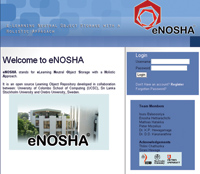 A One Stop Online Repository System of Learning Objects Classroom Windows
A One Stop Online Repository System of Learning Objects Classroom Windows
In a country like Sri Lanka, more than 100,000 students per year do not have access to tertiary education. One of the primary reasons being the lack of repository and storage of the e-learning objects and developed content. eNOSHA is a free, open and flexible learning object repository
In a country like Sri Lanka, more than 100,000 students per year do not have any access to tertiary education. One of the primary reasons being the lack of repository and storage of the e-learning objects and developed content, as around 50 new courses though have been created and stored in the Moodle virtual learning environment, it still lacks adequate structure, metadata or search mechanism.
Addressing this challenge, the discussions in the Europeandiscussions in the European – Sri Lankan eBIT project during 2006 and 2007, paved the way for creating an online system for
storing learning objects, named eNOSHA system by the LOR group in the Swedish – Sri Lankan NeLC project funded by the Swedish International Development Agency (SIDA).
A LOR is a storage and search system for digital learning material for reusing and sharing the content. From the very beginning some of the,
 fundamental design ideas were to reuseor develop a LOR that should be free,open and fl exible enough to serve allstakeholders at the UCSC e-LearningCentre.
fundamental design ideas were to reuseor develop a LOR that should be free,open and fl exible enough to serve allstakeholders at the UCSC e-LearningCentre.
CHALLENGE
Lack of free and open learning object repositories.
METHODOLOGY
Based on the traditional face-to-face meetings as well as in online distance meetings between UCSC in Sri Lanka, Focus groups with staff from UCSC and the involved Swedish universities, the eNOSHA development is based on a participatory design principle where
the presu mptive users have been iteratively consulted in matters ofusability, user-friendliness, and graphical design. User feedback has been an important factor in creation of the different project sprints and usability tests with scenarios using the new-implemented functionalities.
DESIGNING FOR FLEXIBILITY
eNOSHA is developed keeping in account various needs, like varied curriculum and course structure of different organisations, varied contents, templates supporting bulk uploading so that it can be used in different organisations as per the needs and requirements.
GENERAL DESIGN AND MODULARISATION
eNOSHA is built on an idea about some core modules that can be extended with auxiliary units. The very fact that different universities and organisations have different needs, eNOSHA system in all aspects is so designed that it can be extendible and users should be able
to develop and attach their own modules without affecting the core functionality.
THE METADATA SET
LOM is a huge standard that covers a lot of metadata aspects. Metadata is often defi ned as data about data and is an important tool to categorise objects in LORs and make them searchable. All existing courses in the BIT, eBIT and FIT programmes at UCSC exclusively use digital content following the SCORM standard.
LEARNING OBJECTS GRANULARITY
A learning object can more specifi cally be defi ned as “any reusable digital resource that is encapsulated in a lesson or assemblage of lessons grouped in units, modules, courses, and even
programmes.” To facilitate reuse and to decrease context dependency a LOR needs to divide courses and course modules into more fi ne-grained units. In the UCSC adapted version of the
eNOSHA system learning objects are divided into four granularity level
























